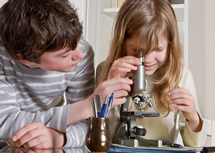
A report released July 19 by the National Research Council proposes a new framework for K-12 science education that emphasizes deep understanding of key topics and practices, and proposes that K-12 science education be built in three dimensions: core ideas, cross-cutting concepts relevant across disciplines, and key practices.
The framework will serve as a foundation for new K-12 science education standards in response to demand for more U.S. workers in science fields.
The report identifies failures in current science education that result in too few U.S. workers with strong scientific backgrounds and too many who lack basic scientific knowledge. In particular, the report criticizes disorganization over multiple years of school, preoccupation with breadth over depth, and a lack of student engagement as crippling to science education.
The authoring committee says it wants science education to ensure that by the end of 12th grade, students have an appreciation for the wonder of science, sufficient knowledge to engage in scientific discussion, and skills required for careers in science, technology, and engineering.
“The report has provided a new, more coherent, and connected way to look at science education in K-12 by bringing together discipline and scientific elements,” said Francis Eberle, executive director of the National Science Teachers Association. “We’ve always known about them, but they’ve created a framework for how they hold together.”
Instead of trying to cover a huge range of topics, the report says, science educators should focus on deepening knowledge of a limited number of core ideas in four disciplines: life sciences; physical sciences; earth and space sciences; and engineering, technology, and application of science.
In the earth and space sciences discipline, for example, students would be required to focus on the core ideas of “Earth’s place in the universe,” “Earth’s systems,” and “Earth and human activity.” Under the new framework, students would increase their understanding of these specified ideas over time and be assessed on benchmarks in grades two, five, eight, and 12.
To further maintain consistency throughout multiple years of schooling, the report recommends that teachers adopt a common language for “cross-cutting concepts” that are relevant in multiple fields. These cross-cutting concepts would serve a purpose similar to the “unifying concepts” or “common themes” included in previous sets of standards.
After hearing the terms used by teachers in multiple disciplines, students would become familiar with common vocabulary such as “cause and effect” and “structure and function.
As students learn the disciplinary core ideas, they should learn not only common vocabulary, but also common practices. The report identifies eight key scientific and engineering practices that should be integrated into science education, including “developing and using models” and “analyzing and interpreting data.”
“To support students’ meaningful learning in science and engineering, all three dimensions [core ideas, cross-cutting concepts, and practices] need to be integrated into standards, curriculum, instruction, and assessment,” the report says.
“The production of this report has done a very good job in the charge that they had,” Eberle said. “Of course there’s still much to do, but it’s a good start to the journey.”
The framework is the first step in a two-step process to develop new K-12 science education standards. Nonprofit educational organization Achieve Inc. will lead a group of states to create more specific standards based on the broad ideas and practices proposed by the framework.
Once Achieve Inc. finishes the standards, states may voluntarily use them to guide science education in public schools in the same way that they previously used Science for All Americans and Benchmarks for Science Literacy (1993) developed by the American Association for the Advancement of Science (AAAS), as well as the National Science Education Standards (1996) developed by the National Research Council.
The new framework distinguishes itself from older standards by offering justification for the inclusion of certain ideas in science education, rather than merely providing long lists that can be time-consuming for teachers to work with, Eberle said.
“There’s a wonder and a curiosity in the sciences that we’ve lost because we’re getting caught up in all these standards,” Eberle said. “But in this report they’ve left room for that, left room and flexibility for teachers in what and how they teach.”
- Incident response plans help district address student safety - September 5, 2011
- Viewpoint: A rational approach to student-teacher ratios - September 1, 2011
- Hybrid approach drives retention success - September 1, 2011


Comments are closed.